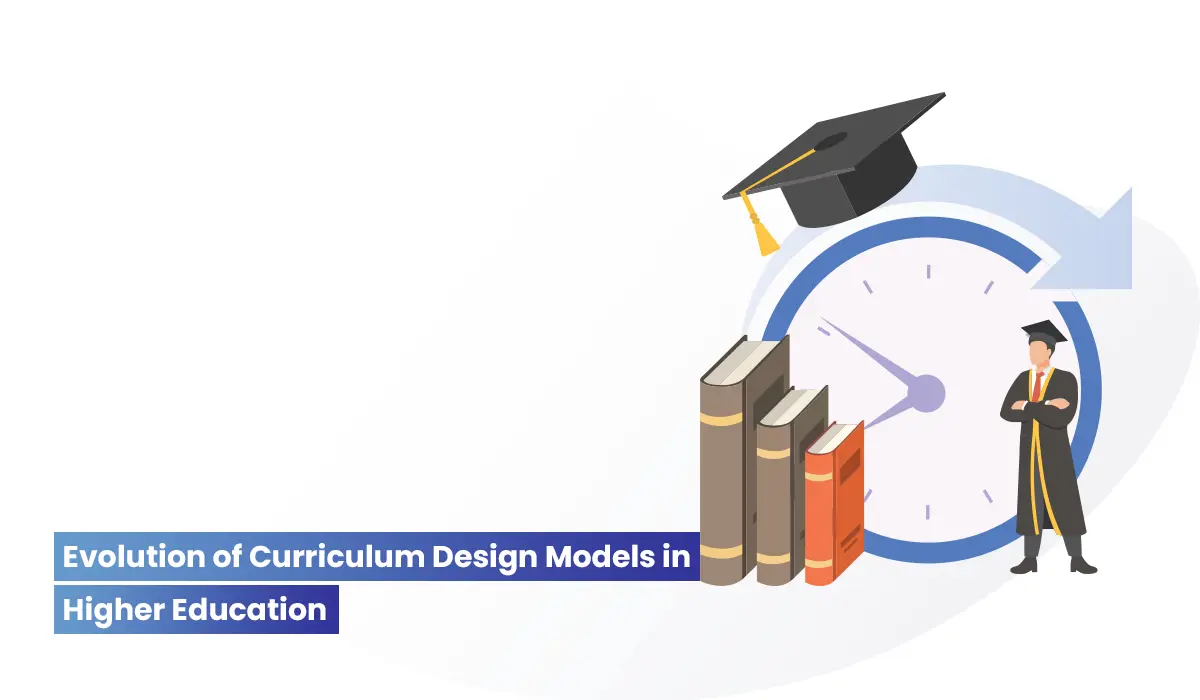What is Bloom’s taxonomy? Importance and uses explained

Introduction to Bloom’s Taxonomy
The statement, "A fish definitely cannot be assessed for its ability to climb a tree," is a starting point for our discussion on the absurdity of using one-size-fits-all methods in education. Learning practices and evaluation techniques are revolutionized by Bloom's Taxonomy, which emerges as a beacon of educational change in today's competitive higher education landscape. Recognizing the variety of skill sets and capacities Bloom's Taxonomy highlights how individual students' learning journeys are. This blog article examines the complexities of Bloom's Taxonomy and its consequences for contemporary education. How about we start with a thorough rundown?
What is Bloom’s Taxonomy?
The classification system known as Bloom's taxonomy is used to define and classify the various stages of thinking, learning, and understanding in humans. It has a hierarchical framework that categorizes learning objectives based on their complexity, ranging from basic information and comprehension to higher evaluation and creativity.
The approach was developed to encourage more advanced thinking methods in the classroom. Instead of just remembering facts, Bloom’s Taxonomy method involves assessing and evaluating concepts, methods, procedures, and principles.
Despite several objections, Bloom's Taxonomy is still extensively applied in educational settings today. It is used by institutions to enhance their curricula, exams, and teaching strategies.
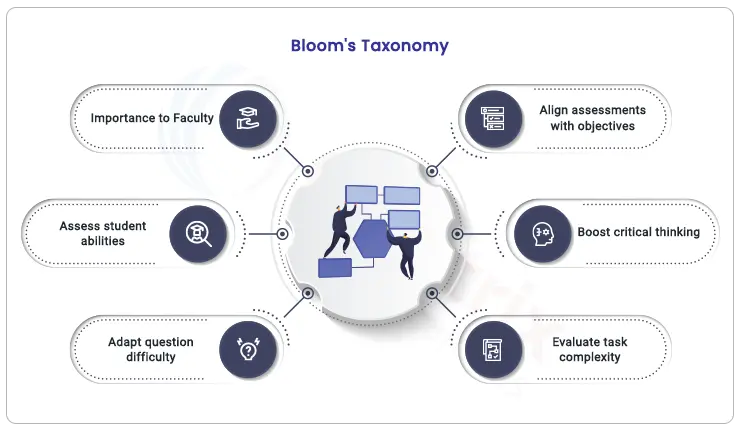
The framework was created by Benjamin Bloom, an American psychiatrist who made several contributions to education, talent development, and mastery learning. Part of his team was Mr. Walter Hill, Mr. Edward Furst, Mr. Max Englehart, and Mr. David Krathwohl who were crucial to Benjamin Bloom in his classification process.
Historical context of Bloom’s Taxonomy: in chronological order
1. Benjamin Bloom was an educational psychologist working at the University of Chicago. He proposed the taxonomy in 1956.
2. Handbook I: Cognitive, the first volume of taxonomy, was published in 1956. Initially, the hierarchy of the cognitive domain was like the one below.
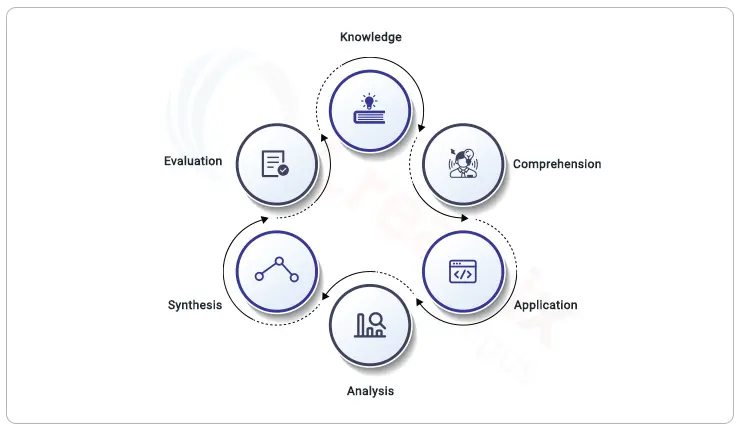
3. Handbook II: Affective, the second volume of taxonomy, was published in 1964.
4. The framework, known as the revised Bloom's Taxonomy, happened in 2001 and looks like the one below.
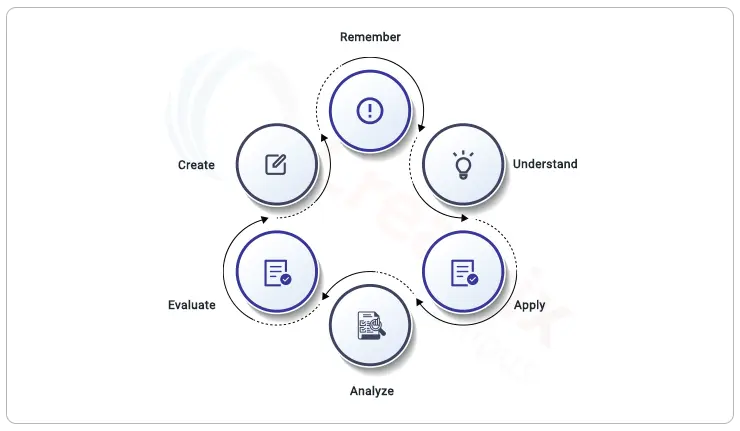
What are the three domains of Bloom’s Taxonomy?
The three categories of the boom taxonomy are;
1. The cognitive or intellectual domain (Knowledge-based)
2. The affective or emotional domain (Emotion-based)
3. The psychological-motor or affective domain (Action-based)
I. Cognitive Domain
The growth of knowledge and intellectual abilities is given the most attention in Bloom's taxonomy's cognitive domain. It is further divided into six subheads based on its complexity.
Level 1: Knowledge - Gaining knowledge of statistics, facts, and fundamental ideas.
Level 2: Comprehension - Comprehending the information acquired during the knowledge stage.
Level 3: Application - Applying the concepts and knowledge in the most effective way possible.
Level 4: Analysis - Evaluating the application, drawing conclusions, and comprehending connections between its various components.
Level 5: Evaluation - Assessing the worth of concepts, resources, or phenomena
Level 6: Creation - Planning, designing, and developing the learning to produce new results.
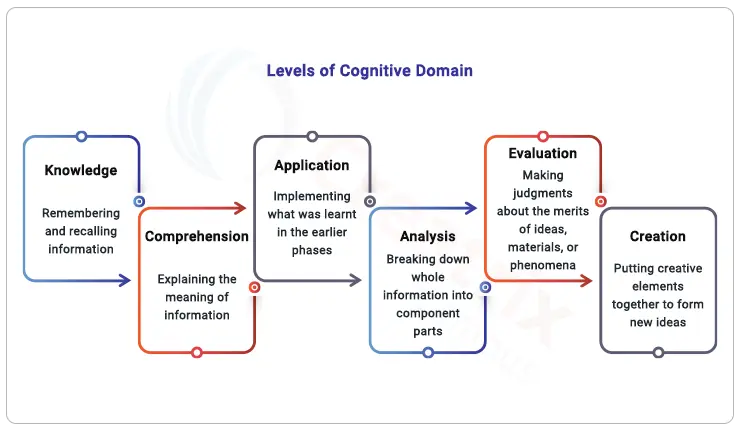
II. Affective Domain
The ability to feel the joy or pain of other living things is one of the abilities in the affective domain. It includes complicated phenomena, characters, and ideas. Affective goals typically focus on increasing awareness of and development of attitudes, emotions, and feelings.
The affective domain has five levels, from the simplest processes to the most complex:
- Reception: A lowest of all levels, this is where the student merely observes passively. There can be no learning without this level. Receiving also involves the student's memory and recognition.
- Response: The student actively engages in the learning process by responding in some way to the stimulus as well as paying attention to it. The student is prepared to act and motivated to respond at this stage.
- Values: The student gives something, a phenomenon, or a piece of knowledge value. The learned knowledge is connected by the student to a value or set of values.
- Organization: The student is able to combine various beliefs, facts, and concepts and fit them into his or her own mental model, by comparing, relating, and expanding on what they have learned.
- Characterization: At this level, the student tries to develop abstract knowledge, internalize their values completely, and act in line with them.
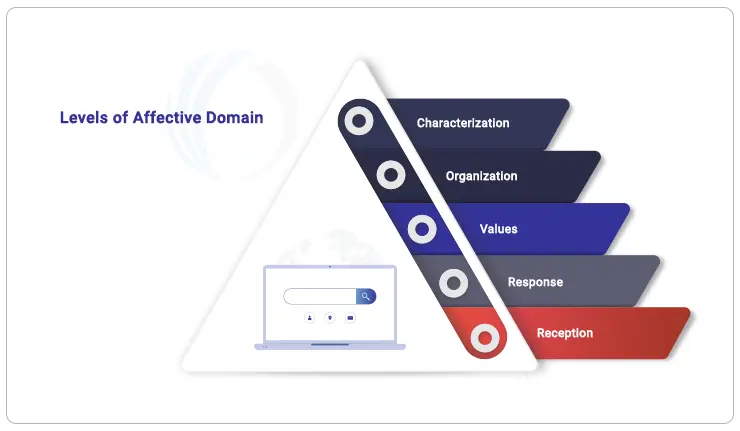
III. Psychomotor Domain
The psychomotor objective is particular to bodily processes, reflex responses, and body movements for information interpretation and learning. It implies that engaging in physical activity fosters or serves as a means of advancing learning and abilities. The learner engages in physical activity to fulfill a cognitive or affective goal.
Its five levels are as follows:
Imitation: The learner will directly copy actions seen and replicate them to what has been directly observed at this level.
Manipulation: At this level, the learner will replicate an activity using memory and instruction.
Precision: The learner will use skills without assistance at this level.
Articulation: At this level, the student will modify their expertise to complete an unusual task.
Naturalization: The learner will automate skills and subconsciously master them at this level.
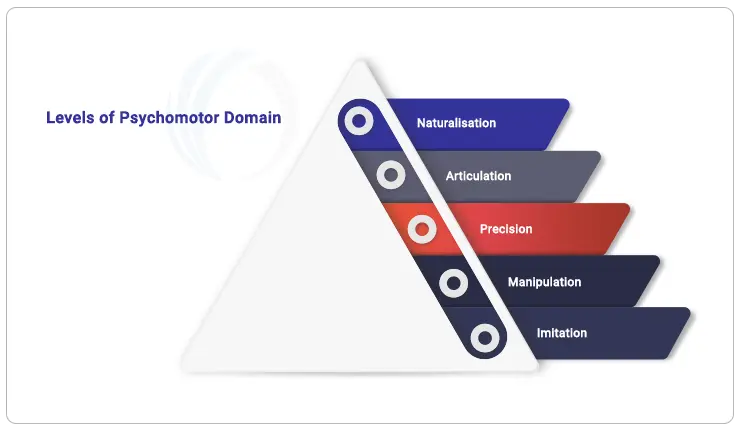
What are the 6 levels of Bloom's Taxonomy?
Let's now look more closely at each of Bloom's taxonomy's six cognitive levels and see how they might be used in the classroom. In order to further explain the types of thinking that are involved at each level, specific verbs are assigned to each level.
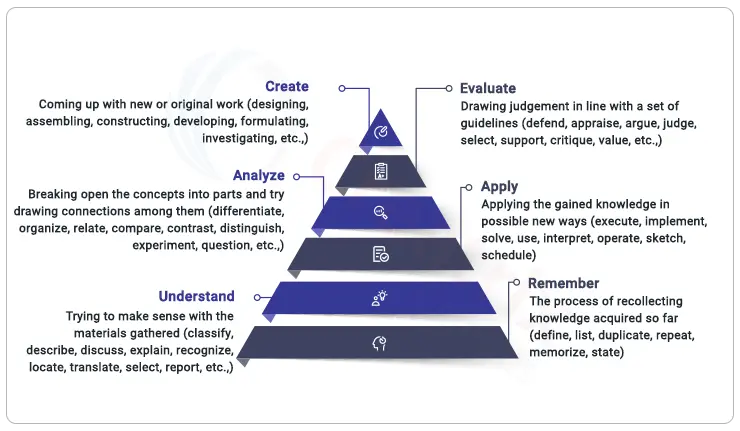
Level one – Remember
Verbs: Describe, list, recite, identify, label, name, repeat.
The process of remembering involves retrieving information and can be used to create lists or definitions. The knowledge level of a student acts as a "springboard" in unlocking the other levels. Although it is the lowest taxonomic level, it is crucial for the learning process because it requires knowledge acquisition before learners can interact with it at higher cognitive levels.
Examples: Reciting the timetable, identifying various human body parts, selecting the correct answer to a true or false question, recalling significant events on a historical timeline, or even naming the six cognitive levels of Bloom's taxonomy are examples of remembering.
Level two – Comprehension
Verbs: Examine, group, generalize, order, sort, paraphrase, rephrase.
Regardless of how well a student performs on the assessment or how well he or she understands a concept, the value of education is when he or she truly understands it. Therefore the concept of comprehension or understanding can be a game changer for students seeking a successful career.
As a result, students must concentrate on comprehending the teachings thoroughly and not taking them lightly.
Examples: Understanding can be shown, for instance, by classifying a list of animals into the appropriate groups (marine, avian, terrestrial, and amphibian), explaining how one historical event affected another, addressing the lesson of a story, etc.
Level three – Application
Verbs: Compute, direct, demonstrate, formulate, dramatize, present, formulate, make.
The third level of Bloom's taxonomy, Application, represents a fundamental shift from pre-learning Bloom's because it requires remembering what has been learned. It is all about having a good understanding of the knowledge, and then being able to apply it to real-world exercises, challenges, or situations. Instead of just studying how to fix a tube light meticulously, the student should really be able to apply it in the real world when his tube light fuses. That’s where he would apply his knowledge in real life.
Examples: Some other examples include making repairs to a computer's parts, acting out mediation and conflict resolution between two warring nations, or giving a presentation on climate change solutions are a few examples of applying in action.
Level four – Analyses
Verbs: simplify, distinguish, criticize, illustrate, question, explain, inspect, question.
Analyzing implies that a student can take complex information and simplify or summarise it. It is a necessary task. It simply implies that the students must not accept something simply because someone says it. They must develop the ability to distinguish between what is authentic and what is not. It would assist students in dealing with any situation that may arise in their careers.
Examples: Some examples include being able to explain why one historic military campaign failed and another succeeded, as well as critically examining aspects of Bloom's original taxonomy and explaining why his students later updated them.
Level five – Evaluation
Verbs: Decide, weigh, prioritize, forecast, value, judge, revise.
This level requires the learner to make criteria-based decisions through the critiquing and checking processes. Only after passing all earlier stages are the students able to move on to this stage. The entire process requires some time; it won't happen overnight. However, educators must motivate students to advance through all levels and acquire knowledge that will enable them to realize their aspirations.
Examples: Evaluating could entail reading a book and writing a review on its merits; suggesting ways to incorporate digital technology into the classroom environment, or making an informed decision in a role-play of court case proceedings.
Level six – Creation
Verbs: Construct, develop, write, invent, develop, set up, originate.
The creation of a new, coherent product from a variety of components is the focus of this highest taxonomic level. This level builds on all of the previous levels as the learner recalls, comprehends, and applies knowledge while also analyzing, evaluating, and creating the final product, which could be either physical or conceptual.
Examples: It can be interpreted as a student writing a book on a subject or designing a tool that will benefit society in some way. Planning and constructing a house out of wooden planks and creating a 3D model of a house on a computer are some of the other examples.
Why use Bloom’s Taxonomy?
Learning goals or objectives must be established in a pedagogical interaction so that both teachers and students understand the real purpose behind it. Having a well-organized set of objectives assists teachers in "planning and delivering appropriate instruction. Bloom’s Taxonomy application helps in the following:
- Using application and understanding, determine the meanings of the words, phrases, and idioms used in the paragraph.
- Using evaluation and analysis, conclude the passage and its points.
- Acquiring information and retaining it through understanding and remembering
- Using the evaluation concept, one can determine the author's tone of voice.
Importance of Bloom’s Taxonomy in the Higher Education Design
To Faculty
- Bloom's Taxonomy assists educators in determining the intellectual level at which individual students can work and develop clear objectives in their framework.
- Faculty can better understand the goals of the classroom alter the questions' level of difficulty and aid learners in ascending the hierarchical scale.
- It can help develop assessments by matching course learning objectives to any given level of mastery.
- It also helps faculty improve their critical thinking.
- Additionally, it can offer a framework for cognitive behaviors that can be used to evaluate tasks, understand how difficult they are, and simplify or complicate them.
To students
- Bloom's taxonomy encourages higher-order thinking in the students by building up lower-level cognitive skills.
- It helps students' brains grow stronger - According to research, the critical thinking ability developed through the use of Bloom's Taxonomy's higher-level thinking skills strengthens the brain and creates more synapses between nerve cells.
- It assists students in developing skills that employers want - Surveys of employers show that they want to hire people with the critical thinking skills demonstrated in higher education. They specifically state that they prefer problem-solving skills over memorization of coursework.
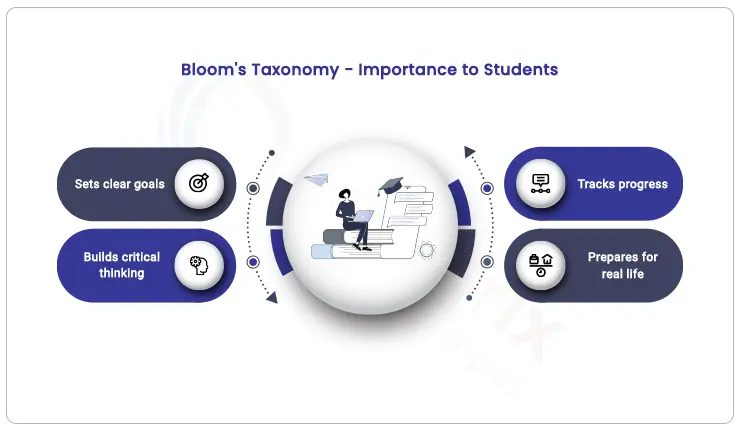
To institutions
- Bloom's Taxonomy can be useful for course designers to develop curricula that the industry demands.
- It helps achieve better outcomes and track and improve progress.
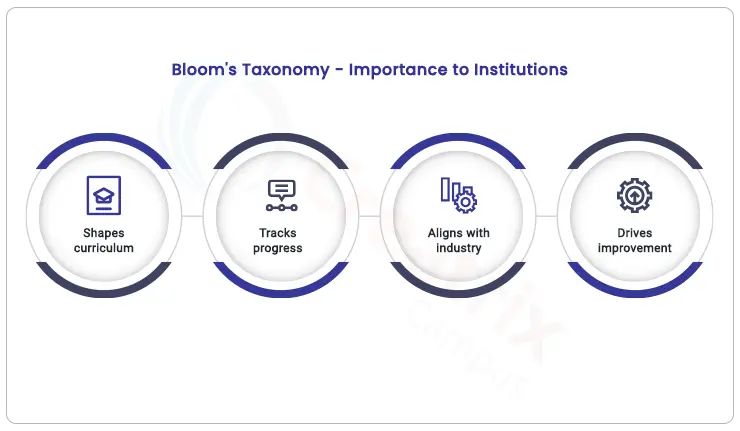
Integrating Educational Technology with Bloom's Taxonomy
Integrating instructional technology with Bloom's Taxonomy entails designing tools at each level of the taxonomy, which are explained in detail below;
Remembering and Understanding: Try using comprehension, complex applications, presentations, and simulations.
Applying: Encourage practice via interactive activities and laboratories.
Analyzing: Use platforms that are collaborative in nature and data analysis applications to promote critical thinking.
Evaluating: Developing evaluative abilities through peer reviews and ongoing inclusive assessments.
Creating: Promote expression through multimedia projects and portfolios.
Uses of Bloom's Taxonomy Across Various Educational Settings
Bloom's Taxonomy is used as a core framework in all educational settings, wherever learning is to there to help educators create effective learning experiences all through the year. Curriculum creation, assessment design, and differentiation tactics are facilitated in higher education as well as professional development programs at a corporate level.
K–12 Education: Directs the creation of assessments and instructional plans.
Higher Education Sector: Plans classes to push the critical thinking abilities of its students.
For Employees: Creates employee training courses.
Online Education: Discussion boards and course designs are influenced by online learning.
Special Needs Education: Creation of individualized education plans (IEPs).
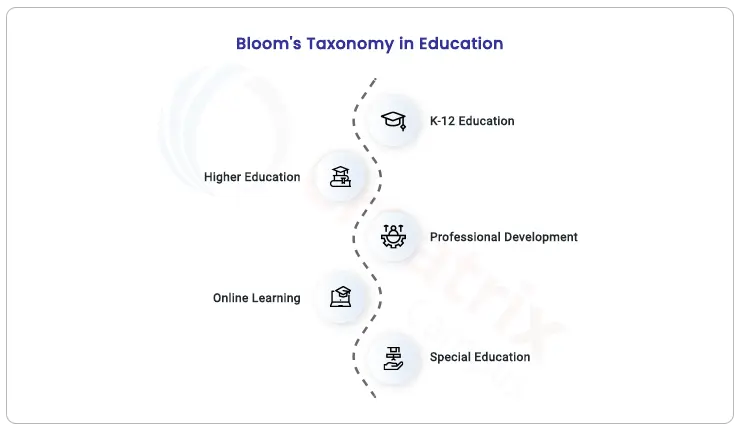
How does Creatrix help you implement Bloom’s taxonomy model?
Integrating Bloom’s Taxonomy into your core curriculum manually can be a tedious process. It could take hours of your faculty and the core curriculum committee’s time. At Creatrix Campus, we help you automate the whole process with greater intelligence and ease.
Without those spreadsheets and emails, Creatrix Campus gives you a big picture of the course-, and program-level attainment of the student(s), so you can keep your team organized, build a quality curriculum, and work towards obtaining accreditation. Here are some ways by which you create a Bloom’s Taxonomic culture at your institution.
- Our curriculum mapping tool helps design and manage a curriculum that makes an impact. It gives you a clear picture of the learning objectives, competencies, and accreditation criteria, and how they impact institutional effectiveness and student success.
- It connects outcomes and assessments with Bloom’s Taxonomy standards.
- Sets learning objective thresholds and objectives to see how learning progresses.
- Eliminates gaps quickly with visual reports and data.
- Prepares for accreditation with data organized under a single place.
- Our Integrated Curriculum Mind Mapping View (CMMV) enables five levels of Bloom’s Complaint Mapping including;
Mapping Courses
- CO - Syllabus Mapping along with Bloom's Taxonomy
- CO - Question Mapping
- CO - Assessments Mapping
- CO - PO / PSO Mapping
- PO - PEO Mapping
A centralized hub for all stakeholders, Creatrix curriculum mapping’s visual representation allows all stakeholders to be on the same page, collaborate better, organize teams, mitigate the risk of content gaps, and improve the courses easily.
No matter whatever stage you are in—curriculum planning, designing, or mapping, we keep you covered. Contact our team for more information.


